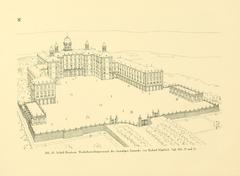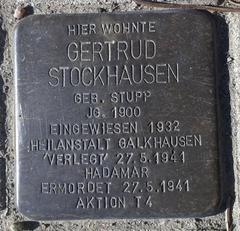Villa Zanders Visiting Hours, Tickets, and Guide to Bergisch Gladbach’s Historical Site
Date: 04/07/2025
Introduction
Located in the heart of Bergisch Gladbach, Germany, Villa Zanders is a remarkable example of 19th-century Neo-Renaissance architecture and a vibrant center for modern and contemporary art. Originally built between 1873 and 1874 for Maria Zanders, widow of the influential paper manufacturer Carl Richard Zanders, the villa was situated next to the family’s paper factory—a testament to the close relationship between industrial enterprise and private life during the Gründerzeit era.
Today, the villa houses the Kunstmuseum Villa Zanders, a unique institution with a special focus on paper-based art, reflecting the city’s papermaking heritage. Visitors can explore elegant historic interiors, such as the renowned Red Salon, and engage with dynamic exhibitions that connect tradition with innovation. This guide provides comprehensive information on visiting hours, tickets, accessibility, nearby attractions, and practical tips to ensure a memorable visit. For the latest updates and event details, always consult the official Villa Zanders website and reputable cultural sources (in-gl.de).
Historical Overview
Origins and Construction
Villa Zanders was commissioned by Maria Zanders, a key figure in Bergisch Gladbach’s industrial and cultural evolution. Built by architect Hermann Otto Pflaume, the villa features a three-story brick structure accented with natural stone, vertical risalits, and a triumphal arch motif—hallmarks of the French Renaissance style (villa-zanders.de). Its original mansard roof and landscaped park underscored the grandeur typical of the period. The villa’s proximity to the Zanders paper factory exemplified the era’s integration of business and domestic life (wikiwand.com).
The Zanders Family Legacy
For nearly sixty years, Villa Zanders was home to the Zanders family. Maria Zanders, a passionate art collector and painter, established the villa not only as a residence but also as a cultural and social hub. Following her death in 1904, her son Hans Zanders continued the family legacy until 1915, after which his widow remained until 1932 (villa-zanders.de). The family’s deep ties to the paper industry are still celebrated through the museum’s focus on paper art (in-gl.de).
Transition to Public Ownership and Restoration
After passing to public ownership in 1932, Villa Zanders served as an administrative center until the 1970s, when it fell into disrepair. Threatened by possible demolition, the villa was saved thanks to its designation as a protected monument in 1982 (wikiwand.com). From 1985 to 1992, the building underwent extensive restoration, preserving its historic character while adapting it for public and cultural use. In 1992, it reopened as the “Städtische Galerie Villa Zanders,” and was renamed Kunstmuseum Villa Zanders in 2014.
Architectural and Cultural Significance
Villa Zanders stands out as one of the few well-preserved Gründerzeit villas in the Rhineland, where the original spatial relationship between the factory and residence remains evident (villa-zanders.de). Its harmonious facades, natural stone detailing, and historic interiors such as the Red Salon and winter garden set the stage for both art exhibitions and special events. The villa’s architecture represents not only the prosperity of the late 19th-century bourgeoisie but also a space for experimentation and personal expression (villamagazine.org).
Kunstmuseum Villa Zanders: Collections and Exhibitions
Artistic Focus
The museum is renowned for its emphasis on art from paper, a nod to Bergisch Gladbach’s papermaking legacy. The collection includes:
- Art from Paper: Showcasing sculpture, installations, and mixed media works that explore paper’s expressive capabilities (in-gl.de).
- Düsseldorf School of Painting: Featuring 19th-century works that provide historical context for German art (thecrazytourist.com).
- Permanent Collection: Includes 26 biblical-themed oil paintings by Maria Zanders.
- Rotating Exhibitions: Innovative solo and group shows, such as “Kunst ohne Grund: Hängende Skulpturen und Installationen aus Papier,” and contemporary showcases by notable artists (villa-zanders.de).
Community Engagement
The museum offers regular workshops, guided tours, and participatory events for all ages, including interactive experiences like escape games and the annual KinderKünstlerFest in the villa’s park (rheinbergnews.de).
Visitor Information
Location and Arrival
- Address: Konrad-Adenauer-Platz 8, 51465 Bergisch Gladbach
- Access: Walkable from Bergisch Gladbach train station; local buses and public parking nearby (villa-zanders.de).
Opening Hours
- Tuesday to Sunday: 11:00 AM – 6:00 PM
- Closed: Mondays and most public holidays
- Special Openings: 26 December and 1 January; free admission during city festivals
- Check current hours: official website
Tickets
- Standard Admission: €5 for adults
- Discounts: Students, seniors, and groups
- Children under 18: Free
- School and kindergarten groups: €0.50 per child; accompanying adults free
- Special events and guided tours: May require separate booking and fees
Accessibility
- Barrier-Free: Ramp at the north entrance, elevator, and accessible restrooms
- Assistance: Staff available for visitors with special needs; free entry for accompanying persons with disabilities (villa-zanders.de)
Visitor Amenities
- Information Desk: Bilingual staff
- Cloakroom: Secure storage available
- Restrooms: Accessible on all floors
- Museum Shop: Art books, catalogues, postcards, and unique paper gifts
- No onsite café: Several cafés and restaurants are located nearby
Special Events and Concerts
Villa Zanders hosts the annual “Galeriekonzerte” series—six concerts featuring contemporary music, jazz, and improvisation in the villa’s historic rooms (bergischgladbach.de). Tickets cost €12.50 with concessions available.
Educational Programs and Family Activities
The museum runs workshops, interactive tours, and activities for children, families, and schools, often coinciding with major exhibitions or school holidays.
Architectural and Historical Ambience
As a protected monument, Villa Zanders preserves ornate ceilings, period woodwork, and other original features that immerse visitors in 19th-century bourgeois culture. The blending of historic architecture with contemporary art creates a unique, inspiring setting.
Nearby Attractions
While visiting Villa Zanders, consider exploring other Bergisch Gladbach historical sites:
- Papiermühle Alte Dombach: Museum celebrating papermaking
- Kindergartenmuseum: Focus on early childhood education
- Schulmuseum Katterbach: Exhibits on regional schooling history
- Old Town (Altstadt): Quaint shops and cafés
- Bürgerhaus “Bergischer Löwe”: Adjacent cultural venue
Combine your trip with a stroll through the villa’s park or the city’s “Kulturmeile” (Cultural Mile) (bergischgladbach.de).
Frequently Asked Questions (FAQ)
Q: What are Villa Zanders’ visiting hours?
A: Tuesday to Sunday, 11:00 AM to 6:00 PM. Closed Mondays and most public holidays.
Q: How much are tickets?
A: Adults €5, with discounts for students, seniors, and groups. Children under 18 enter free.
Q: Is the museum wheelchair accessible?
A: Yes, with ramps, elevators, and accessible restrooms available.
Q: Are guided tours available?
A: Yes, guided tours can be booked in advance and tailored to exhibitions or interests.
Q: Can I take photos inside?
A: Non-flash photography is generally permitted in permanent exhibitions.
Q: Are there workshops or educational programs?
A: Yes, for children, families, and adults—check the museum’s website for schedules.
Practical Tips
- Plan ahead: Check for special exhibitions, guided tours, or concerts.
- Combine your visit: Explore nearby museums and Bergisch Gladbach’s city center.
- Language: Exhibition texts are in German and English; staff are bilingual.
- Photography: Allowed in most areas, but confirm on-site.
Booking and Contact
For the latest on exhibitions, events, and visitor services, consult the official Villa Zanders website, or contact the museum directly for group bookings and special requests.
Conclusion
Villa Zanders is a true cultural gem in Bergisch Gladbach, offering an immersive experience at the intersection of history, architecture, and contemporary art. With accessible facilities, engaging exhibitions, and a rich program of concerts and workshops, it’s a destination for art lovers, families, and history enthusiasts alike. Download the Audiala app for real-time updates, audio guides, and event notifications. Plan your visit today and discover the enduring legacy and artistic vibrancy of Villa Zanders—one of the Rhineland’s most treasured historical sites.
Further Reading and Official Resources
- Villa Zanders: Exploring Bergisch Gladbach’s Historical Gem with Visiting Hours, Tickets, and More, 2025
- Kunstmuseum Villa Zanders Visiting Hours, Tickets & Bergisch Gladbach Historical Sites Guide, 2025
- Villa Zanders: Visiting Hours, Tickets, and a Guide to Bergisch Gladbach’s Historic Art Museum, 2025
- Visitor Experience at Villa Zanders: Visiting Hours, Tickets, and Bergisch Gladbach Historical Sites, 2025
- Papier Gefaltet in Raum und Zeit – Kunst ohne Grund: Kunstmuseum Villa Zanders, Bergisch Gladbach, 2025

